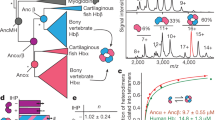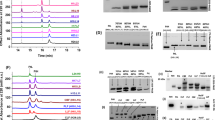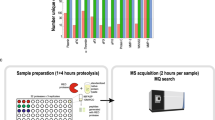Abstract
PURIFIED haptoglobins of the three common genetic types (Hp 1–1, Hp 2–1 and Hp 2–2), after reductive cleavage with mercaptoethanol in the presence of urea, yield two classes of product (Smithies, O., Connell, G. E., and Dixon, G. H.; in preparation). One group of the cleavage products fails to migrate in acidic starch-gels (except in the presence of 8 M urea), and appears to be common to haptoglobin of all the genetic types. The other cleavage products, which migrate readily, differ according to the genetic type of haptoglobin. The homozygous type haptoglobin 1–1 gives a migrating product different from that obtained with haptoglobin of the other homozygous type 2–2 ; heterozygous haptoglobin gives both products.
This is a preview of subscription content, access via your institution
Access options
Subscribe to this journal
Receive 51 print issues and online access
$199.00 per year
only $3.90 per issue
Buy this article
- Purchase on Springer Link
- Instant access to full article PDF
Prices may be subject to local taxes which are calculated during checkout
Similar content being viewed by others
References
Ingram, V. M., Biochim. Biophys. Acta, 28, 539 (1958).
Smithies, O., and Walker, N. F., Nature, 176, 1265 (1955); 178, 694 (1956).
Brown, H., Sanger, F., and Kitai, R., Biochem. J., 60, 556 (1955).
Author information
Authors and Affiliations
Rights and permissions
About this article
Cite this article
CONNELL, G., DIXON, G. & SMITHIES, O. Subdivision of the Three Common Haptoglobin Types based on ‘Hidden’ Differences. Nature 193, 505–506 (1962). https://doi.org/10.1038/193505a0
Issue Date:
DOI: https://doi.org/10.1038/193505a0
This article is cited by
-
The influence of site-specificity of single amino acid substitutions on electrophoretic separation of yeast iso-1-cytochromec
Journal of Molecular Evolution (1991)
-
Macromolecular interaction and the electrophoretic mobility of esterase-5 from Drosophila pseudoobscura
Biochemical Genetics (1987)
-
Subtyping of haptoglobin — Presentation of a new method
Human Genetics (1985)
-
Duplication within the haptoglobin Hp2 gene
Nature (1984)
-
Molecular charge and electrophoretic mobility in cetacean myoglobins of known sequence
Biochemical Genetics (1984)
Comments
By submitting a comment you agree to abide by our Terms and Community Guidelines. If you find something abusive or that does not comply with our terms or guidelines please flag it as inappropriate.



